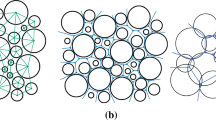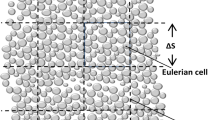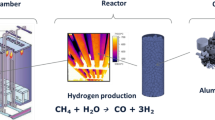Abstract
The knowledge of structural properties of granular materials such as porosity is highly important in many application-oriented and scientific fields. In this paper we present new results of computer-based packing simulations where we use the non-smooth granular dynamics (NSGD) method to simulate gravitational random dense packing of spherical particles with various particle size distributions and two types of depositional conditions. A bin packing scenario was used to compare simulation results to laboratory porosity measurements and to quantify the sensitivity of the NSGD regarding critical simulation parameters such as time step size. The results of the bin packing simulations agree well with laboratory measurements across all particle size distributions with all absolute errors below 1%. A large-scale packing scenario with periodic side walls was used to simulate the packing of up to 855,600 spherical particles with various particle size distributions (PSD). Simulation outcomes are used to quantify the effect of particle-domain-size ratio on the packing compaction. A simple correction model, based on the coordination number, is employed to compensate for this effect on the porosity and to determine the relationship between PSD and porosity. Promising accuracy and stability results paired with excellent computational performance recommend the application of NSGD for large-scale packing simulations, e.g. to further enhance the generation of representative granular deposits.










Similar content being viewed by others
References
Rumpf HCH, Gupte AR (1971) Einflüsse der Porosität und Korngrößenverteilung im Widerstandsgesetz der Porenströmung. Chem Ing Tech 43:367–375. doi:10.1002/cite.330430610
Hatch CE, Fisher AT, Ruehl CR, Stemler G (2010) Spatial and temporal variations in streambed hydraulic conductivity quantified with time-series thermal methods. J Hydrol 389:276–288. doi:10.1016/j.jhydrol.2010.05.046
Wilcock PR (1998) Two-fraction model of initial sediment motion in gravel-bed rivers. Science 280:410–412
Vollmer S, Kleinhans MG (2007) Predicting incipient motion, including the effect of turbulent pressure fluctuations in the bed. Water Resour Res 43:W05410. doi:10.1029/2006WR004919
Athy LF (1930) Density, porosity, and compaction of sedimentary rocks. AAPG Bull 14:1–24
Boulton AJ, Findlay S, Marmonier P, Stanley EH, Valett HM (1998) The functional significance of the hyporheic zone in streams and rivers. Annu Rev Ecol Evolut Syst 29:59–81
Carling PA, Reader NA (1982) Structure, composition and bulk properties of upland stream gravels. Earth Surface Process Landf 7:349–365
Wu W, Wang SSY (2006) Formulas for sediment porosity and settling velocity. J Hydraul Eng 132:858–862
Wooster JK, Dusterhoff SR, Cui YT, Sklar LS, Dietrich WE, Malko M (2008) Sediment supply and relative size distribution effects on fine sediment infiltration into immobile gravels. Water Resour Res 44:W03424
Frings RM, Schüttrumpf H, Vollmer S (2011) Verification of porosity predictors for fluvial sand-gravel deposits. Water Resour Res 47:W07525
Desmond KW, Weeks ER (2014) Influence of particle size distribution on random close packing of spheres. Phys Rev E 90:022204. doi:10.1103/PhysRevE.90.022204
Ouchlyama N, Tanaka T (1984) Porosity estimation for random packings of spherical particles. Ind Eng Chem Fundam 23:490–493
Suzuki M, Oshima T (1985) Verification of a model for estimating the void fraction in a three-component randomly packed bed. Powder Technol 43:147–153
Yu AB, Standish N (1991) Estimation of the porosity of particle mixtures by a linearc-mixture packing model. Ind Eng Chem Res 30:1372–1385
Koltermann CE, Gorelick SM (1995) Fractional packing model for hydraulic conductivity derived from sediment mixtures. Water Resour Res 31:3283–3297
Esselburn JD, Robert WRJ, Dominic DF (2011) Porosity and permeability in ternary sediment mixtures. Ground Water 49:393–402
Frings RM, Kleinhans MG, Vollmer S (2008) Discriminating between pore-filling load and bed-structure load: a new porosity-based method, exemplified for the river Rhine. Sedimentology 55:1571–1593
Abbireddy COR, Clayton CRI (2015) The impact of particle form on the packing and shear behaviour of some granular materials: an experimental study. Granul Matter 17:427–438. doi:10.1007/s10035-015-0566-0
Fang HW, Zhao HM, Chen ZH, Chen MH, Zhang YF (2015) 3D shape and morphology characterization of sediment particles. Granul Matter 17:135–143. doi:10.1007/s10035-014-0545-x
Jia X, Williams RA (2001) A packing algorithm for particles of arbitrary shapes. Powder Technol 120:175–186
Papanicolaou A, Diplas P, Evaggelopoulos N, Fotopoulos S (2002) Stochastic incipient motion criterion for spheres under various bed packing conditions. J Hydraul Eng 128:369–380
Gan M, Gopinathan N, Jia X, Williams RA (2004) Predicting packing characteristics of particles of arbitrary shapes. Kona 22:82–93
Liang R, Schruff T, Jia X, Schüttrumpf H, Frings RM (2015) Validation of a stochastic digital packing algorithm for porosity prediction in fluvial gravel deposits. Sediment Geol 329:18–27. doi:10.1016/j.sedgeo.2015.09.002
Preclik T, Rüde U (2015) Ultrascale simulations of non-smooth granular dynamics. Comput Part Mech 2(2):173–196. doi:10.1007/s40571-015-0047-6
Moreau J, Panagiotopoulos P (1988) Nonsmooth mechanics and applications, vol 302. Springer, Wien
Schruff T, Schornbaum F, Godenschwager C, Rüde U, Frings RM, Schüttrumpf H (2014) Numerical simulation of pore fluid flow and fine sediment infiltration into the riverbed. In: International conference on hydroinformatics, Paper 300. http://academicworks.cuny.edu/cc_conf_hic/300. Accessed 25 Aug 2015
Fattahi E, Waluga C, Wohlmuth B, Rüde U, Manhart M, Helmig R (2015) Pore-scale lattice Boltzmann simulation of laminar and turbulent flow through a sphere pack. arXiv:1508.02960
Fattahi E, Waluga C, Wohlmuth B, Rüde U (2015) Large scale lattice Boltzmann simulation for the coupling of free and porous media flow. arXiv:1507.06565
Winkler P, Salehi Sadaghiani MR, Jentsch H, Witt KJ (2014) Granular packing generation using DEM–modified force-biased-algorithm. Scour Eros. doi:10.1201/b17703-43
Horner DA, Peters JF, Carrillo A (2001) Large scale discrete element modeling of vehicle–soil interaction. J Eng Mech 127:1027–1032. doi:10.1061/(ASCE)0733-9399(2001)127:10(1027)
Kleinert J, Obermayr M, Balzer M (2013) Modeling of large scale granular systems using the discrete element method and the non-smooth contact dynamics method: a comparison. In: Proceedings of the ECCOMAS multibody dynamics conference, Zagreb
Estrada N, Lizcano A, Taboada A (2010) Simulation of cemented granular materials. I. Macroscopic stress–strain response and strain localization. Phys Rev E 82:011303. doi:10.1103/PhysRevE.82.011303
Radjai F, Dubois F (2011) Discrete-element modeling of granular materials., Iste seriesWiley, New York
Negrut D, Tasora A, Negrini S (2012) A compliant contact model based on differential variational inequalities. Presented at the the 2nd joint international conference on multibody system dynamics, DEU, pp 1–8
Alonso-Marroquín F, Wang Y (2009) An efficient algorithm for granular dynamics simulations with complex-shaped objects. Granul Matter 11:317–329. doi:10.1007/s10035-009-0139-1
Krabbenhoft K, Huang J, da Silva MV, Lyamin AV (2012) Granular contact dynamics with particle elasticity. Granul Matter 14:607–619. doi:10.1007/s10035-012-0360-1
Acary V, Brogliato B (2008) Numerical methods for nonsmooth dynamical systems., Lecture notes in applied and computational mechanicsSpringer, Berlin
Jülich Supercomputing Centre (2015) JUQUEEN: IBM Blue Gene/Q supercomputer system at the Jülich Supercomputing Centre. J Large-scale Res Facil 1:A1. doi:10.17815/jlsrf-1-18
Iglberger K, Rüde U (2009) Massively parallel rigid body dynamics simulations. Comput Sci Res Dev 23:159–167. doi:10.1007/s00450-009-0066-8
Iglberger K, Rüde U (2010) Massively parallel granular flow simulations with non-spherical particles. Comput Sci Res Dev 25:105–113. doi:10.1007/s00450-010-0114-4
Iglberger K, Rüde U (2011) Large-scale rigid body simulations. Multibody Syst Dyn 25:81–95. doi:10.1007/s11044-010-9212-0
Bear J (1972) Dynamics of fluids in porous media. Dover Publications, New York
Ismail JH, Fairweather M, Javed KH (2002) Structural properties of beds packed with ternary mixtures of spherical particles: part I—global properties. Chem Eng Res Des 80:637–644
Kamann PJ, Ritzi RW, Dominic DF, Conrad CM (2007) Porosity and permeability in sediment mixtures. Ground Water 45:429–438
Rosas J, Lopez O, Missimer TM, Coulibaly KM, Dehwah AHA, Sesler K, Lujan LR, Mantilla D (2014) Determination of hydraulic conductivity from grain-size distribution for different depositional environments. Groundwater 52:399–413
Song C, Wang P, Makse HA (2008) A phase diagram for jammed matter. Nature 453:629–632. doi:10.1038/nature06981
Acknowledgements
The authors of this paper are grateful to Ferdinand Habbel B.Sc. RWTH, Dr.-Ing. Tobias Preclik, and Katrin Wieneke M.Sc. RWTH for their support and insightful discussions. Additionally, the authors gratefully acknowledge the computing time granted by the JARA-HPC Vergabegremium and provided on the JARA-HPC Partition part of the supercomputer JUQUEEN [39] at Forschungszentrum Jülich. This work was supported by HPSC-TerrSys (Centre for High-Performance Scientific Computing in Terrestrial Systems), Helmholtz Society.
Author information
Authors and Affiliations
Corresponding author
Rights and permissions
About this article
Cite this article
Schruff, T., Liang, R., Rüde, U. et al. Generation of dense granular deposits for porosity analysis: assessment and application of large-scale non-smooth granular dynamics. Comp. Part. Mech. 5, 59–70 (2018). https://doi.org/10.1007/s40571-016-0153-0
Received:
Revised:
Accepted:
Published:
Issue Date:
DOI: https://doi.org/10.1007/s40571-016-0153-0




